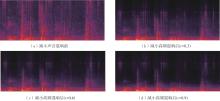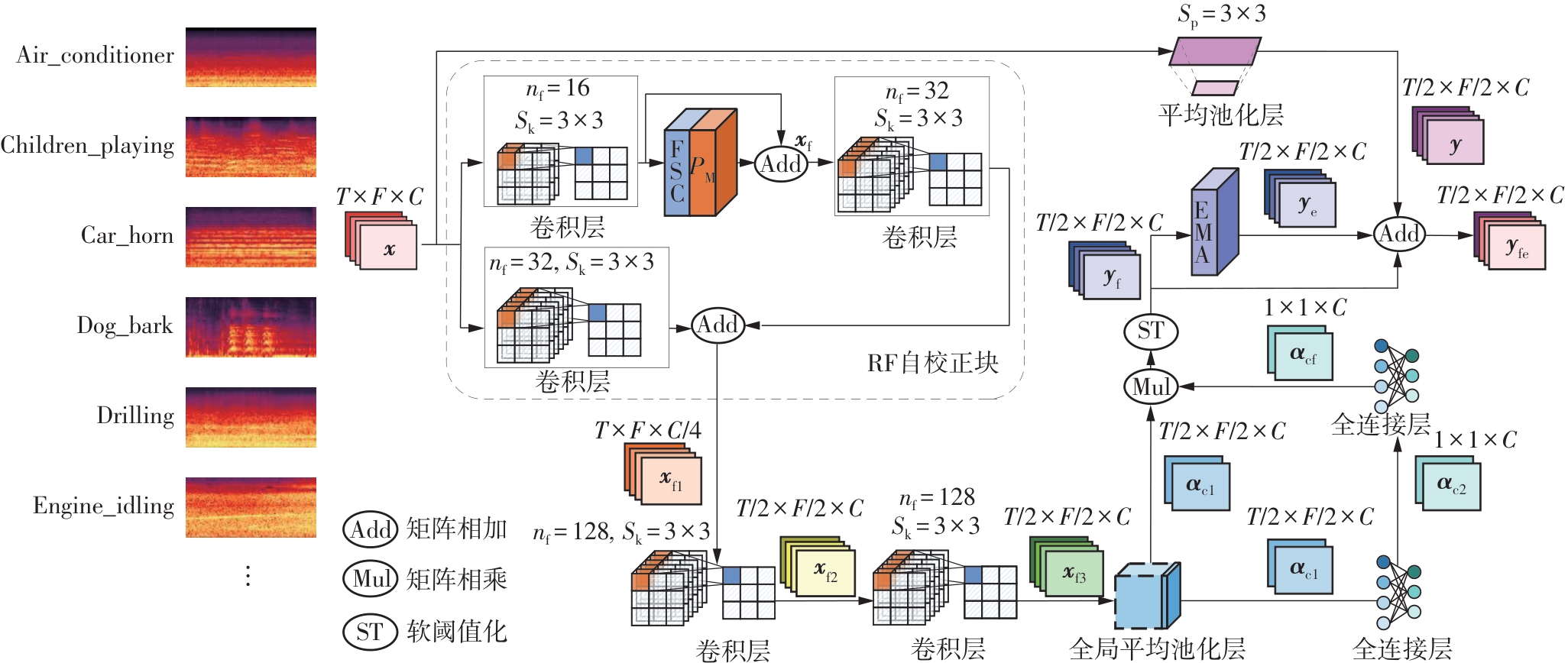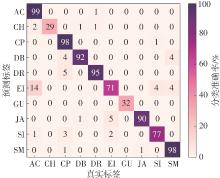Journal of South China University of Technology(Natural Science Edition) ›› 2025, Vol. 53 ›› Issue (7): 70-79.doi: 10.12141/j.issn.1000-565X.240508
• Electronics, Communication & Automation Technology • Previous Articles Next Articles
Acoustic Scene Classification Method Based on Reducing High-Frequency Reverberation and RF-DRSN-EMA
CAO Yi, WANG Yanwen, LI Jie, ZHENG Zhi, SUN Hao
- School of Mechanical Engineering/ Jiangsu Key Laboratory of Advanced Food Manufacturing Equipment and Technology,Jiangnan University,Wuxi 214122,Jiangsu,China
-
Received:2024-10-14Online:2025-07-25Published:2025-01-17 -
About author:曹毅(1974—),男,博士,教授,主要从事语音识别技术研究。E-mail: caoyi@jiangnan.edu.cn -
Supported by:the National Natural Science Foundation of China(52175234);the Programme of Introducing Talents of Discipline to Universities(B18027)
CLC Number:
Cite this article
CAO Yi, WANG Yanwen, LI Jie, ZHENG Zhi, SUN Hao. Acoustic Scene Classification Method Based on Reducing High-Frequency Reverberation and RF-DRSN-EMA[J]. Journal of South China University of Technology(Natural Science Edition), 2025, 53(7): 70-79.
share this article
Table 1
Comparison of classification accuracy of F-DRSN dereverberation in different frequency bands"
| 频段 | UrbanSound8K | DCASE2020 Task 1A | ||||
|---|---|---|---|---|---|---|
| Log-Mel | Gamma | GFCC | Log-Mel | Gamma | GFCC | |
| 未增强 | 85.17 | 84.57 | 83.85 | 67.34 | 69.58 | 66.72 |
| 低频段 | 85.65 | 87.32 | 85.89 | 68.45 | 69.68 | 68.86 |
| 中频段 | 84.69 | 83.25 | 84.93 | 67.60 | 70.20 | 67.45 |
| 高频段 | 87.80 | 87.68 | 86.12 | 70.20 | 71.10 | 69.32 |
| 全频段 | 86.72 | 86.36 | 86.01 | 69.16 | 70.72 | 68.59 |
Table 5
Comparison of classification accuracy among different acoustic scene classification methods"
| 方法 | 声学特征 | 分类准确率/% | ||
|---|---|---|---|---|
| ESC-10 | UrbanSound8K | DCASE 2020 Task 1A | ||
| F-DRSN | Log-Mel | 89.50 | 85.17 | 67.34 |
| SVM | MFCC | 71.00 | ||
| 文献[ | Mel | 54.10 | ||
| Mini-SegNet[ | Log-Mel | 71.26 | ||
| ResNet-18[ | Log-Mel | 71.80 | ||
| Trident ResNet + MDEL[ | Mel | 72.60 | ||
| 文献[ | Gamma | 80.20 | 89.00 | |
| N-DenseNet[ | MFCC | 83.63 | ||
| D-2-DenseNet[ | MFCC+GFCC | 84.83 | ||
| ESResNet[ | Log-power spec | 97.00 | 85.42 | |
| 1D CNN[ | Gamma | 89.00 | ||
| ResNet-50[ | Log-Mel | 93.10 | ||
| RF-DRSN-EMA | L_Ga | 98.00 | 93.42 | 72.80 |
| [1] | 董绍江,夏蒸富,方能炜,等 .基于颜色通道特征融合的环境声音分类方法[J].应用科学学报,2023,41(4):669-681. |
| DONG Shaojiang, XIA Zhengfu, FANG Nengwei,et al .Environmental sound classification method based on color channel feature fusion[J].Journal of Applied Sciences,2023,41(4):669-681. | |
| [2] | MAHYUB M, SOUZA L S, BATALO B,et al .Signal latent subspace:a new representation for environmental sound classification[J].Applied Acoustics,2024,225:110181/1-13. |
| [3] | ZHANG H Y, WU M L, CAI X C,et al .An event-scene cooperative analysis network with dual-stream attention convolution module and soft parameter-sharing[J].Applied Acoustics,2024,222:110066/1-9. |
| [4] | JESUDHAS P P, RANJAN P V .A novel approach to build a low complexity smart sound recognition system for domestic environment[J].Applied Acoustics,2024,221:110028/1-14. |
| [5] | HOU Y, KANG B, MITCHELL A,et al .Cooperative scene-event modelling for acoustic scene classification [J].IEEE/ACM Transactions on Audio,Speech,and Language Processing,2023,32:68-82. |
| [6] | MILLING M, LIU S, TRIANTAFYLLOPOULOS A,et al .Audio enhancement for computer audition:an iterative training paradigm using sample importance[J].Journal of Computer Science and Technology,2024,39(4):895-911. |
| [7] | SONG S Y, SONG Y J, MADHU N .Robust detection of background acoustic scene in the presence of foreground speech[J].Applied Sciences,2024,14(2):609/1-13. |
| [8] | YANG L P, TAO L J, CHEN X X,et al .Multi-scale semantic feature fusion and data augmentation for acou-stic scene classification[J].Applied Acoustics,2020,163:107238/1-10. |
| [9] | JIANG G, MA Z C, MAO Q,et al .Multi-level distance embedding learning for robust acoustic scene classification with unseen devices[J].Pattern Analysis and Applications,2023,26(3):1089-1099. |
| [10] | 曹毅,费鸿博,李平,等 .基于多流卷积和数据增强的声场景分类方法[J].华中科技大学学报(自然科学版),2022,50(4):40-46. |
| CAO Yi, FEI Hongbo, LI Ping,et al .Acoustic scene classification method based on multi-stream convolution and data augmentation[J].Journal of Huazhong University of Science and Technology (Natural Science Edition),2022,50(4):40-46. | |
| [11] | GUZHOV A, RAUE F, HEES J,et al .ESResNet:environmental sound classification based on visual domain models[C]∥ Proceedings of the 25th International Conference on Pattern Recognition.Milan:IEEE,2021:4933-4940. |
| [12] | KARAM S, RUAN S J, HAP Q M,et al .Episodic memory based continual learning without catastrophic forgetting for environmental sound classification[J].Journal of Ambient Intelligence and Humanized Compu-ting,2023,14(4):4439-4449. |
| [13] | QU Y, LI X, QIN Z,et al .Acoustic scene classification based on three-dimensional multi-channel feature-correlated deep learning networks[J].Scientific Reports,2022,12:13730/1-11. |
| [14] | 曹毅,黄子龙,张威,等 . N-DenseNet的城市声音事件分类模型[J].西安电子科技大学学报,2019,46(6):9-16,94. |
| CAO Yi, HUANG Zilong, ZHANG Wei,et al .Urban sound event classification with the N-order dense convolutional network[J].Journal of Xidian University,2019,46(6):9-16,94. | |
| [15] | HUANG Z L, LIU C, FEI H B,et al .Urban sound classification based on 2-order dense convolutional net-work using dual features[J].Applied Acoustics,2020,164(2):107243/1-9. |
| [16] | 曹毅,黄子龙,盛永健,等 .D-2-DenseNet噪音鲁棒的城市音频分类模型[J].北京邮电大学学报,2021,44(1):86-91. |
| CAO Yi, HUANG Zi-long, SHENG Yong-jian,et al .Noise robust urban audio classification based on 2-order dense convolutional network using dual features[J].Journal of Beijing University of Posts and Telecommunications,2021,44(1):86-91. | |
| [17] | 高长丰,程高峰,张鹏远 .面向鲁棒自动语音识别的一致性自监督学习方法[J].声学学报,2023,48(3):578-587. |
| GAO Changfeng, CHENG Gaofeng, ZHANG Pengyuan. Consistency self-supervised learning method for robust automatic speech recognition[J].Acta Acustica, 2023,48(3):578-587. | |
| [18] | 费鸿博,吴伟官,李平,等 .基于梅尔频谱分离和LSCNet的声学场景分类方法[J].哈尔滨工业大学学报,2022,54(5):124-130. |
| FEI Hongbo, WU Weiguan, LI Ping,et al .Acoustic scene classification method based on Mel-spectrogram separation and LSCNet[J].Journal of Harbin Institute of Technology,2022,54(5):124-130. | |
| [19] | YOSHIOKA T, NAKATANI T .Generalization of multi-channel linear prediction methods for blind MI-MO impulse response shortening[J].IEEE Transactions on Audio,Speech,and Language Processing,2012,20(10):2707-2720. |
| [20] | YANG Z, ZHANG M, CHEN J .Distributed speech dereverberation using weighted prediction error[J].Signal Processing,2024,225:109577/1-5. |
| [21] | ADELMAN N W, JEONG C .Investigation on accep-table reverberation time at various frequency bands in halls that present amplified music[J].Applied Acou-stics,2018,129:104-107. |
| [22] | ZHANG X, JIANG S .Application of Fourier transform and butterworth filter in signal denoising[C]∥ Proceedings of the 6th International Conference on Intelligent Computing and Signal Processing.Xian:IEEE,2021:1277-1281. |
| [23] | ZHAO M, ZHONG S, FU X,et al .Deep residual shrinkage networks for fault diagnosis[J].IEEE Tran-sactions on Industrial Informatics,2020,16(7):4681-4690. |
| [24] | FENG Q, HAN L, ZHAO B,et al .Microseismic events recognition via joint deep clustering with residual shrinkage dense network[J].IEEE Transactions on Geoscience and Remote Sensing,2023,61:1-11. |
| [25] | WANG L, ZOU T, CAI K,et al .Rolling bearing fault diagnosis method based on improved residual shrinkage network[J].Journal of the Brazilian Society of Mechanical Sciences and Engineering,2024,46(3):172/1-12. |
| [26] | OUYANG D, HE S, ZHANG G Z,et al .Efficient multi-scale attention module with cross-spatial learning [C]∥ Proceedings of 2023 IEEE International Confe-rence on Acoustics,Speech and Signal Processing.Rhodes Island:IEEE,2023:1-5. |
| [27] | PICZAKI K J .ESC:dataset for environmental sound classification[C]∥ Proceeding of the 23rd ACM International Conference on Multimedia.New York:ACM,2015:1015-1018. |
| [28] | SALAMON J, JACOBY C, BELLO J P .A dataset and taxonomy for urban sound research[C]∥ Procee-ding of the 22nd ACM International Conference on Multimedia.New York:ACM,2014:1041-1044. |
| [29] | HEITTOLA T, MESAROS A, VIRTANEN T .TAU urban acoustic scenes 2020 mobile, development dataset [DB/OL]. (2020-06-01)[2024-10-14].. |
| [30] | 王玥,钱志鸿,王雪,等 .基于伽马通滤波器组的听觉特征提取算法研究[J].电子学报,2010,38(3):525-528. |
| WANG Yue, QIAN Zhi-hong, WANG Xue,et al .An auditory feature extraction algorithm based on γ-tone filter-banks[J].Acta Electronica Sinica,2010,38(3):525-528. | |
| [31] | SALAMON J, BELLO J P .Deep convolutional neural networks and data augmentation for environmental sound classification[J].IEEE Signal Processing Le-tters,2017,24(3):279-283. |
| [32] | GUPTA S S, HOSSAIN S, KIM K D .Recognize the surrounding:development and evaluation of convolutional deep networks using gammatone spectrograms and raw audio signals[J].Expert Systems with Applications,2022,200:116998/1-15. |
| [33] | HEITTOLA T, MESAROS A, VIRTANEN T .Acou-stic scene classification in DCASE 2020 challenge:generalization across devices and low complexity solutions [EB/OL].(2020-01-02)[2024-10-14].. |
| [34] | SHAO Y F, MA X X, MA Y,et al .Deep semantic learning for acoustic scene classification[J].EURASIP Journal on Audio, Speech and Music Processing,2024,2024:1/1-15. |
| [35] | GAO W, McDONNELL M D .Acoustic scene classification using deep residual networks with focal loss and mild domain adaptation[R].Adelaide:University of South Australia,2020:1-2. |
| [36] | ABDOLI S, CARDINAL P, KOERICH A L .End-to-end environmental sound classification using a 1D convolutional neural network[J].Expert Systems with Applications,2019,136:252-263. |
| [1] | ZHAO Rongchao, WU Baili, CHEN Zhuyun, et al. Graph Neural Network for Fault Diagnosis with Multi-Scale Time-Spatial Information Fusion Mechanism [J]. Journal of South China University of Technology(Natural Science Edition), 2023, 51(12): 42-52. |
| [2] | LIU Jieping, WEN Junwen, LIANG Yaling. Monocular Image Depth Estimation Based on Multi-Scale Attention Oriented Network [J]. Journal of South China University of Technology (Natural Science Edition), 2020, 48(12): 52-62. |
| Viewed | ||||||
|
Full text |
|
|||||
|
Abstract |
|
|||||









